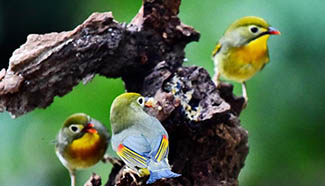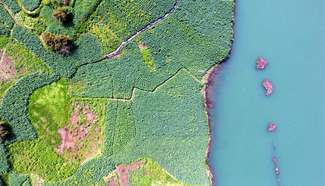LHASA, Feb. 27 (Xinhua) -- Although Tibetans have been on their week-long New Year holiday, Tse Dekyi, a sanitation worker in Lhasa, got up early and started cleaning the street at 5 a.m. Sunday.
Sunday marked Tibetan New Year's Eve, as Losar, the Tibetan new year, fell on Monday this year. Losar is marked by religious rituals, long prayers, horse racing, family gatherings and feasts.
Tse Dekyi's husband, 66-year-old Chosphel Nyima, also got up early on Sunday morning. As head of the household, he had to climb on a high stool and take down the old color cloth above the door frame, replacing it with a new one.
The cloth, sewn with silk of five colors, is a symbol of happiness and good fortune used to decorate Tibetan windows and doors.
The old couple's home is a run-down rented house in downtown Lhasa, just 30 square meters in size, where they brought up their eight daughters and five sons. Now, they have more family members -- six sons-in-law and seven grandsons and granddaughters.
On New Year's Eve, all family members returned for a gathering.
During lunch, Tse Dekyi rushed home to prepare a tribute for the new year.
On the altar in the living room there are placed, a pastry in the shape of a sheep head, a pot of highland barley, dates, air-dried beef, candies, nuts, butter, and brown sugar, presented to pray for prosperity and good weather for crops.
In Tibetan "sheep head" is pronounced similarly to "the year's beginning" thus making it an auspicious symbol.
Chosphel Nyima said in ancient times they used live animals for sacrifice. After Buddhism spread throughout Tibet, they have started to use pastry instead.
"All families plant their own highland barley, which is believed to indicate the harvest in the following year," Chosphel Nyima said. "When I was a child, we were poor and had to prepare the tribute months ahead of the new year. Now, we can buy everything at one time in the market."
After lunch Tse Dekyi left for work, leaving her husband at home alone to prepare the "Qiema."
The Qiema is a two-tier rectangular wooden box containing roasted barley and fried wheat grain. A traditional dish for festive occasions, it is decorated with ears of wheat and a butter sculpture to symbolize harvest in the next year.
"We always do the decoration after the kids go to bed, so that they do not act up," Tse Dekyi said.
Each guest to her home during the new year holiday is invited to see the Qiema. The visitor takes some of the food and throws it into the air, saying "Tashi Delek," meaning "good luck." The host then toasts the guests to wish them a happy new year.
After the feast on the evening of the Tibetan New Year's Eve, the family gather in front of the television to watch the Tibetan New Year gala.
Chosphel Nyima enjoyed the Losar gathering and said his new year's wish was to live a better life.












